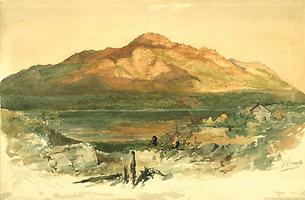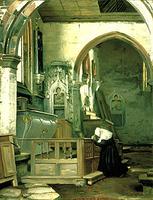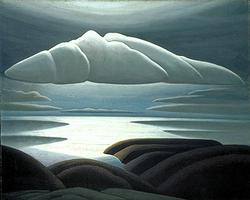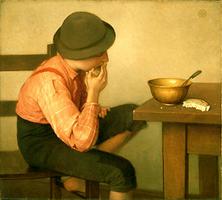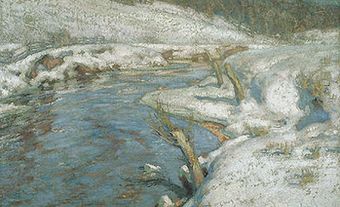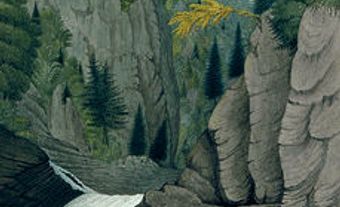Prior to the advent of distinctively Canadian modernists like Tom Thomson, members of the Group of Seven, Emily Carr and David Milne in the 20th century, Canadian painting closely followed conventional, academic European models and tastes. While this did not change after the 1840s, as the century progressed, artists in Canada increasingly began to address specifically Canadian themes.
Art Prior to Confederation
Prior to Confederation, the documentary tradition dominated Canadian painting, whether recording the frontier, high society in the garrison towns, or the scenic wonders of a new land. Romanticism, a major European movement preoccupied with imagination, emotion and the natural world, was a common style in the early and mid-19th century. The most popular and prolific of the romantic painters of the Canadian scene was Holland-born and Quebec-based Cornelius KRIEGHOFF. After 1841, Krieghoff painted a variety of local scenes along the St Lawrence River - some humorous, others anecdotal. He had seen genre painting at the Düsseldorf Academy in Germany and his naturally upbeat temperament transformed his snapshots of everyday life into subjects of immense popular appeal. He had a lifelong interest in Aboriginal peoples and, as his wife was of French birth, he knew the habitant lifestyle intimately. It is interesting that Krieghoff's support came from English-speaking patrons in the Canadas. The French bourgeoisie found in his work a vulgar caricature of habitant life and an insult to their cultured lifestyle.
Parallel to Krieghoff's fascination with the everyday life he observed in Quebec was a growing preoccupation with the western frontier. Swiss-born Peter RINDISBACHER immigrated to the RED RIVER COLONY in 1821 as a boy of 15. He was so excited by the way of life in Fort Garry that he painted a remarkable series of watercolours of the local scene, of Aboriginal peoples in exotic, unfamiliar dress and buffalo on the prairies in winter. Two decades later Paul KANE made himself famous by painting this same western scenery and its Indigenous peoples. He had been a minor Ontario portrait painter who aspired to artistic greatness and studied in Europe. Inspired by George Catlin's American Indian portraits then displayed in London, Kane conceived a similar project of portraying Aboriginal Canadians. During a celebrated wilderness trip with fur traders from Ontario to Fort Vancouver between 1846 and 1848, he sketched the landscape and tribes he encountered. Subsequently, he painted 100 canvases based on these sketches and published an account of his travels. Kane also inspired other artists. In 1872 Frederick VERNER made a similar sketching trip to depict Aboriginal people and buffalo. William G.R. HIND spent a season as an expedition artist with his scientist brother, Henry, exploring Labrador, then joined the 1862 OVERLANDERS, who travelled by land to the newly discovered British Columbia goldfields.
Art and the Birth of Canada
The late 19th century, which was marked by Confederation in 1867, was filled with growth and optimism, and saw industrialization, the Riel rebellions, and western expansion. Yet few of these developments were recorded by contemporary artists. As PHOTOGRAPHY took over the role of documenting society, Victorian artists escaped into an ideal world of rural landscapes. They also established professional art societies, where they could exhibit, promote and sell their works, mostly in Montreal and Toronto.
Several talented artists worked in the studios of William NOTMAN, a Montreal photographer who by the 1860s had achieved an international reputation for his portrait photographs, then went on to greater heights with landscape and genre, or everyday, subjects. The company had its own exhibition space and art collection, and it rapidly became the leading, if unofficial, art school in the country. There was a camaraderie among the staff as they painted in their spare time and made sketching trips to the lakes and hills of the Eastern Townships and beyond. John FRASER, an acknowledged leader, opened a branch in Toronto and was instrumental in organizing the Ontario Society of Artists, providing space in the Notman studio for the society's first annual exhibition in 1873. Associated with him were his brother-in-law, Henry Sandham, who later opened a Notman studio in Saint John, Paris-trained Allan EDSON, and Otto Jacobi, who had enjoyed an earlier career in Germany.
The search for the Canadian landscape by Notman photographers and artists was intimately connected with the railway expansion, which was opening up the new country. Painters had travelled from Montreal by train in the earlier years to sketch in Quebec and the Matapedia Valley. Now they broadened their vision as the transcontinental line of the Canadian Pacific Railway edged its way across the Prairies and through the Rockies. Sir William VAN HORNE, president of the railway and himself an art collector, gave artists free passes to produce promotional pictures for the CPR. Notman sent a camera crew with the work trains to detail progress through the mountains. Fraser and other artists associated with Notman went to the West to make an oil and watercolour record of the magnificent scenery. Their paintings of the West, technically brilliant and marked by photographic realism, dominated many art exhibitions until the end of the century.
Creation of the Royal Canadian Academy of Arts
Canadian art achieved new prestige with the founding of the ROYAL CANADIAN ACADEMY OF ARTS in 1880, primarily through the efforts of the Governor General, John Douglas Sutherland Campbell, Marquess of LORNE, and his wife Princess Louise. Lucius O'BRIEN, first president of the RCA, was swept up in this new search for the true face of Canada. He visited Nova Scotia and New Brunswick, and then, as the railway reached the Pacific, he travelled west to paint the mountains and the Vancouver area. Some of his finest paintings, such as his majestic views of Quebec or Sunrise on the Saguenay (1880), introduced a glowing quality which incorporated the diffuse light characteristic of American painting of the Hudson River School of the same period.
The Influence of Europe
During the 1880s and 1890s, Europe once again became the model for artists in Canada, and painters aspired to study in Parisian academies and exhibit at the Salon, the prestigious and traditionally conservative annual exhibition at the Academie des Beaux-Arts in Paris. It was the conservative French and English masters, not the avant-garde, who attracted the young Canadians, men who painted heroic images in a highly finished naturalistic style. William BRYMNER and Robert HARRIS followed this path and on their return taught "in the French manner" in Montreal and Toronto. In 1883 Harris was commissioned by the federal government to paint The Fathers of Confederation. Paul PEEL was acclaimed in Paris and at home for his studies of bathers and children but he did little that was specifically Canadian. George REID, on the other hand, used the same monumental figurative tradition in his scenes of rural Ontario, such as Mortgaging the Homestead (1890).
Two young painters who derived their inspiration from their rural Canadian surroundings and who visited Europe only after they were established were Homer WATSON and Ozias LEDUC. Watson became a celebrity early on when his etching The Pioneer Mill (1890) was purchased for Queen Victoria's royal collection. Leduc lived in St-Hilaire, Quebec, supporting himself from church decoration while painting still lifes and the people and landscape close to him for his own satisfaction. Meanwhile in Paris, the polished, narrative style of the Salon was increasingly attacked by innovative painters of the impressionist, Barbizon and Hague schools. Horatio WALKER was influenced by this naturalistic depiction of landscape and, on his return to Canada, his paintings of rural scenes on Île d' ORLÉANS rapidly brought him acclaim in North America. In 1911 the National Gallery of Canada paid $10,000 for Oxen Drinking (1899).
Maurice CULLEN and James Wilson MORRICE were among the first artists to apply the principles of French impressionism to the Canadian landscape. Cullen attracted attention in Paris before returning to spend his mature years in Quebec. Criticism was harsh and sales were poor, but he exerted a tremendous influence through his teaching at the Art Association of Montreal. Independently wealthy, Morrice lived much of his life in Paris, travelled widely, befriended Henri Matisse and was influenced by James Whistler. Through annual exhibitions at the Canadian Art Club in Toronto between 1907 and 1915, Cullen, Morrice and Marc-Aurèle de Foy SUZOR-COTÉ served as models for the nextgeneration of Canadian artists.

 Share on Facebook
Share on Facebook Share on X
Share on X Share by Email
Share by Email Share on Google Classroom
Share on Google Classroom



